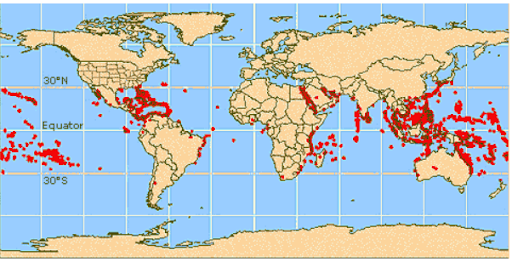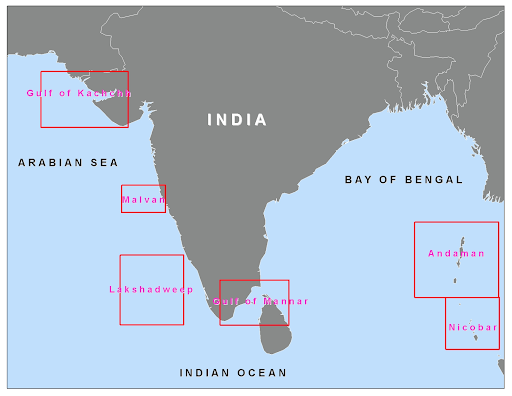Status of Coral Reefs of the World 2020 report
About Coral reefs
- Coral reefs are large underwater structures composed of the skeletons of colonial marine invertebrates called coral.
- The coral species that build reefs are known as hermatypic, or “hard,” corals because they extract calcium carbonate (CaCO3) from seawater to create a hard, durable exoskeleton that protects their soft, sac-like bodies.
- Other species of corals that are not involved in reef building are known as “soft” corals. These types of corals are flexible organisms often resembling plants and trees and include species such as sea fans and sea whips.
Symbiotic relationship
- Most reef-building corals contain photosynthetic algae, called zooxanthellae, that live in their tissues. The corals and algae have a symbiotic relationship.
- The coral provides the algae with a protected environment and compounds they need for photosynthesis. In return, the algae produce oxygen and help the coral to remove wastes. The presence of the zooxanthellae also provides colored pigments to help protect the coral’s white skeleton from sunlight.
Significance of Coral reefs
- Coral reefs only occupy 0.1% of the area of the ocean but they support 25% of all marine species on the planet.
- Because of the diversity of life found in the habitats created by corals, reefs are often called the “rainforests of the sea.”
Geographical distribution
-
- The reef-building corals prefer to grow at
- depths shallower than 30 m (100 ft), or
- where the temperature range is between 16-32°C, and
- The reef-building corals prefer to grow at
- light levels are high
- The majority of reef building corals are found within tropical and subtropical waters. These typically occur between 30°N and 30°S of the equator.
- The largest of these coral reef systems, the Great Barrier Reef in Australia, is more than 1,500 miles long (2,400 kilometers).

Coral reefs in India
- Coral reefs are present in the areas of Gulf of Kutch, Gulf of Mannar, Andaman & Nicobar, Lakshadweep Islands and Malvan coast of Maharashtra.

Main threats to coral reefs
-
- Climate change: Warmer water temperatures can result in coral bleaching. When water is too warm, corals expel the algae (zooxanthellae) living in their tissues causing the coral to turn completely white. This is called coral bleaching. When a coral bleaches, it is not dead. Corals can survive a bleaching event, but they are under more stress and are subject to mortality. The first mass coral bleaching event in 1998 killed about 8 percent of the world’s coral.
- Ocean acidification: Ocean acidification is caused by rising levels of CO2 in the atmosphere. Oceans absorb some of the CO2. As CO2 enters the ocean, it reacts with water increasing hydrogen ion concentration (thus decreasing ocean pH) and decreasing the carbonate ion concentration. A reduction in carbonate ions affects the Calcification process of Corals.
- Calcification is the process by which corals form their skeletons by combining calcium ions and carbonate ions to create calcium carbonate.
- Pollution: Urban and industrial waste, plastics, sewage, agrochemicals, and oil pollution are poisoning reefs. Some pollutants, such as sewage and runoff from farming, increase the level of nitrogen in seawater, causing an overgrowth of algae.
- Sedimentation: Erosion caused by construction, mining, logging, and farming is leading to increased sediment in rivers. This ends up in the ocean, where it can smother corals by depriving them of the light needed to survive.
- Destructive fishing practices: These include cyanide fishing, blast or dynamite fishing, bottom trawling, and muro-ami (banging on the reef with sticks). Bottom-trawling is one of the greatest threats to cold-water coral reefs.
Why in the news?
- Global Coral Reef Monitoring Network (GCRMN), a network of scientists and organisations that monitor the underwater ecosystems has released the sixth edition of its report, “Status of Coral Reefs of the World 2020” after a gap of 13 years.
Key findings of the report
- The network estimates that the world has lost about 14 percent of its coral reefs in the past decade.
- The report says before the decade (2009-2019), on average, there was twice as much coral on the world’s reefs as algae. However now there was 13.7 percent less hard coral on reefs in 2015-19 compared with 2005-09.
- In contrast, since 2010, the amount of algae on the world’s coral reefs has increased by about 20 per cent. (A surge in algal bloom on reef edges indicates unhealthy hard corals)
- During the past 15 years, almost all regions have experienced a decline in average coral cover.
- According to the region-specific status report, South Asia, which accounts for a little over 4 percent of the world’s coral reefs, saw a decline in hard corals due to El Niño-related coral bleaching events in 1998 and 2016. (El Niño is the warm phase of the El Niño Southern Oscillation that affects ocean temperatures)
- Maldives, India and Sri Lanka see anthropogenic stresses due to overfishing, coastal development, pollution and sedimentation.
- According to the report there are chances of recovery in some parts of South Asia and reef recovery is highly variable with better recovery on atolls along the Lakshadweep-Maldives-Chagos Ridge. (Atolls are ring- shaped coral reefs that encircle a lagoon).
- East Asia’s Coral Triangle that accounts for more than 30 percent of the world’s reefs, has also been less impacted. (The Coral Triangle (CT) is a roughly triangular area in the tropical waters around Indonesia, Malaysia, Papua New Guinea, the Philippines, the Solomon Islands and Timor-Leste.)
Conclusion
- This critical ecosystem can recover if the pressure eases. One promising start to these efforts is the UN’s plan to conserve 30 percent of the Earth’s land and seas by 2030.
Subscribe
Login
0 Comments
